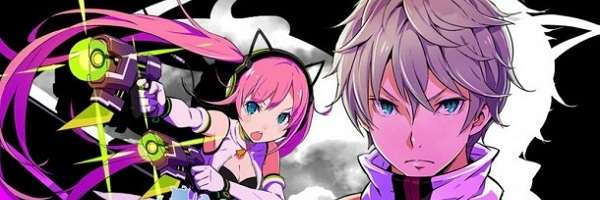
Conception II: Children of the Seven Stars PS Vita Review
With a name like Conception II, the title alone for this latest Atlus published and Spike Chunsoft developed Vita game will no doubt confuse people. But the title perfectly mirrors the cocktail of dungeon crawling blended with Japanese RPG elements with a hint of dating games, and it’s rather fun to play. There are some interesting mechanics based around material that is aimed more for the male audience, thanks to some predictable fan service, but if given the chance, there is a solid RPG to discover here under all this crazy Japanese that I think people will enjoy playing through.
Conception II follows a rather predictable story. You play the hero, who is just arriving at Fort City after finding out that he has the symbol, a mark of the Star God signifying that a person is a chosen one who can use a power known as star energy to defeat monsters that appear out of strange realms known as Dusk Circles. With this sign, the hero attends the school at Fort City to make use of these powers. In the process induction he finds out that he is a A rank disciple. Also at this time, it’s found out that the hero is brimming with much more star energy than anyone else who has arrived at the educational compound. This was foretold in a prophecy, and so the hero is given the title of God’s Gift. With so much energy inside him, God’s Gift can enter the Dusk Circles, the first time for a student, and so he is tasked with going inside these labyrinths and closing them, hopefully eradicating the monsters that leak into the world. God’s Gift has another benefit for the school – he has 100% conception rating when classmating with S rank females, meaning he can produce lots of star children to help with win the fight.
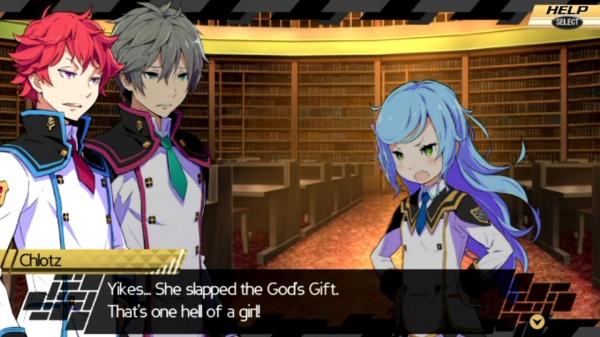
There are two main types of gameplay in Conception II, a mixture of dungeon crawling and story elements, the latter created closely to how visual novels present their stories. This means there is often hefty dialogue before visiting the next story dungeon, which might annoy people who just want to play the game. The dialogue can be skipped, so if you’re not all that interested in a particular scene, especially if you feel a bit awkward when girls talk about their boobs or some of the male characters sound like they just hit puberty in high school, you’re free not to watch. In regards to the topic, there are random sexual innuendos, even when the game isn’t purposely doing it, but because it’s used for jokes in context of the game, you can’t help but think of them. I didn’t’ feel that it became tasteless and insulting. In fact, a lot of more interesting plot is mostly in the side content, as the main story is played safe and never tries to bring something more than a satisfying tale to keep you going forward. An enjoyable, but overall, a lacking story.
Fort City is made up of a menu that pinpoints locations of interest. One of the main areas is Labyrinth, where players will go to progress the story or take part in side-quest labyrinths that will reward with money and items. The Labyrinths in Conception II are based on various themes, but are made up of randomly-generated areas, similar to how the recent Persona games have been crating their dungeons. Although, in Conception II, the dungeon presentations come across less interesting than the likes of Persona 4’s great themes, like the retro dungeon. Each floor of a dungeon has a teleporter that can return you to base, so you are always safe on every floor, unlike Persona 3’s way of requiring the player to hit a certain floor before being able to return to safety. A ton of crystals litter each section, and these contain items, such as healing items or new equipment. In fact, I feel that there are too many of them, because I often found that I always had a large stack of MP restorers or healing items that I never had to go buy more.
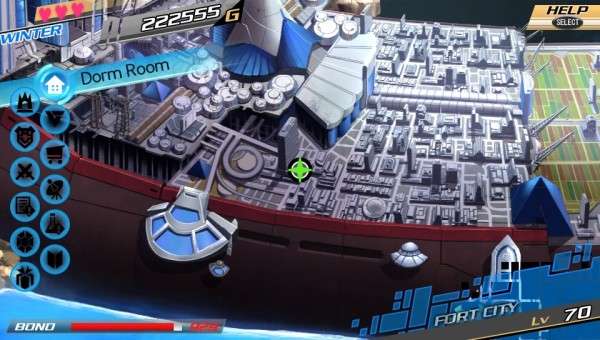
This is an issue that plagues half of the game; it’s just too easy. You will walk over the first few hours without any issues, and it’s not until the latter half that the difficulty increases. I do wonder if it was created like this to welcome new players to the genre or to let people have enough time to craft a good squad of star children, a very key mechanic of the game, so that they wouldn’t feel so disadvantaged later on.
Star children is a unique feature of Conception II and is the game’s most important mechanic. I mentioned earlier about classmating, which is a ritual that involves one of the game’s heroines and your hero. There’s certainly some sexual references coming across here through how people speak about this event, but it’s led to believe that the actual classmating is done through touching hands and thinking about it. The bizarre cutscene that appears before the child is born is made up of a pink silhouette of the heroine, making it look like she’s naked, but with no detail on display it’s hard to know if she is or not, but it’s certainly leading you on. Once the amusingly blue hand appears, which is the only thing you see of the hero, the child pops out of a Matryoshka doll, looking like a kid who has just reached primary school age. Yeah, they are formed from star energy, so that means you don’t have to clean their used diapers as a baby, feed them or give them the attention a normal new born baby would require.
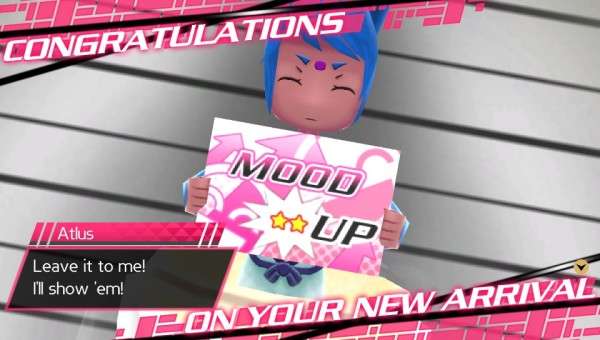
This is where the time spent with the heroines becomes rewarding, as the more you learn about them and their small story arcs the more they become compatible with you and the better the stats are for the star children. Some character arcs are stupid, while others are jolly fun as the hero tries to solve their problems with being small, scared of ghosts or other bizarre things that can only happen in a Japanese RPG. If you want to create star children in all the classes available, then you will have to grow your friendship with the seven heroines. Classes are based on various roles, such as Swordis, Thief, Cleric, Magician, Gunslinger or Hunter, which are all rather self-explanatory, and you can take up to nine with you in battle, which form three groups of three star children. Earlier star children will have low level caps, but as you max the level cap and force them to be independent – they are sent off to live in the city, which levels up the city and in turn offers better items from the shop or unlocks more missions from the guild – the next created star child will often come with a higher level cap, until you hit one at 99, which at that point you ‘ll most likely keep them in your squad for the rest of the game.
The last major gameplay is battles. The hero can take one heroine into battle with him, and if that heroine is the mother of the star children present, she will offer buffs to all her children. It’s a little neat feature that represents motherly love, but the benefits aren’t that big that you are forced to not use another heroine if you decide you want a different companion. Enemies run around the dungeons in forms of large purple gooey blobs, and if you manage to run into them, then you will attack first, unless they get behind you, which will allow them the first strike.
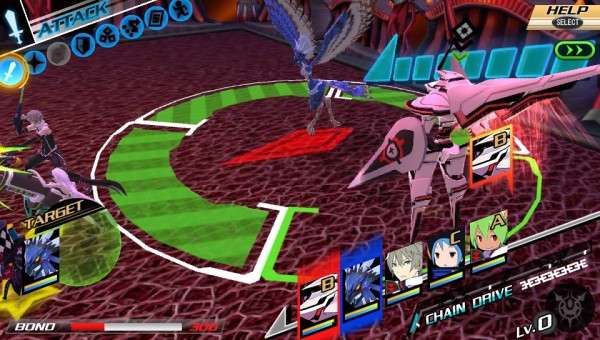
Conception II’s battle mechanics are rather interesting. It’s a system that I haven’t seen in many games before. When you have a maximum party to fight with, you will have your hero group (with the heroine), then the three groups of three star children. These are treated as four members when it comes to the turn-based battle system. Any skills that a character has in that group can be used during that turn, so if you have a group of star children that includes a Swordis, a Magician and a Thief, then you have the chance to pick attack for all or pick one skill from any of their move set, the other two members will attack, while the character with the designated skill will perform the action.
Attackers need to have their positioning selected, with back, front or the two sides available. Most monsters will be weak from the back or side, so it’s often best to aim for there. Positioning is important, as you cannot have any two groups of star children sharing the same location on an enemy. If there is more than one enemy, then you can attack that one instead. Enemies aren’t just in a line, as there is a grid system in place that keeps the enemies separate from each other, but it doesn’t cost anything to aim at another enemy,a strange thing, as it costs an enemy who is free from battle a turn to move closer to your party members. Fights are fast and fluid, and can be made even faster by turning fast forward on with a click of the shoulder button, or turn on automatic fighting if you know you can beat the enemy without an issue. It’s great, as you’re never in battle for too long. This also means grinding can be done in quick phases if you feel the need to power up your characters. One thing I really love is how weaker enemies don’t even get to fight you. If you are strong enough, then touching an enemy on the map will instantly kill it and yourself and the star children get the experience. It’s simply fantastic and I wish more RPGs did this.
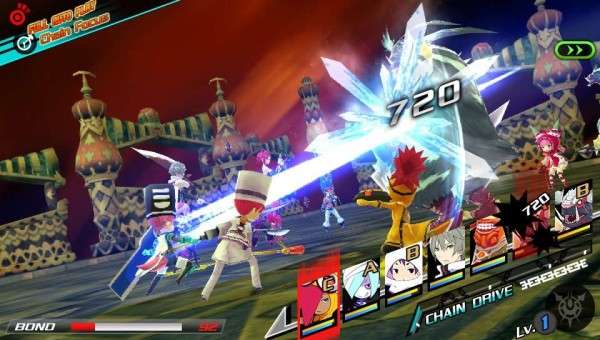
A problem arises that you feel like you’re repeating the same objectives. You do a bit of story, go into the Labyrinths, talk to the heroines and then go back to the dungeons. While Persona can be said to have a similar progression that game was backed up with more interesting characters, side-content, story and battles. Conception II doesn’t master any of these, it’s a solid RPG that lacks the depth and soul of the Persona games.
The art is fairly generic anime and the dungeon designs uninspiring, but there’s no doubt that Conception II performs really well on Vita. This game looks sharp, the 3d models are detailed, especially during the close ups, the 2D art is clean, but overuses the boob jiggle. More detail could have gone to mouth movement, as their bodies move to simulate breathing, but they mouth doesn’t move for speech. A good note to mention is the performance, as the game runs at 60FPS and doesn’t often drop that frame rate. This game simply is best on Vita, as the 3DS version runs at half the frame rate, loses all its sharpness, due to the lower resolution screen and the image quality is worse, thanks to the induction of aliasing on the 3D models.
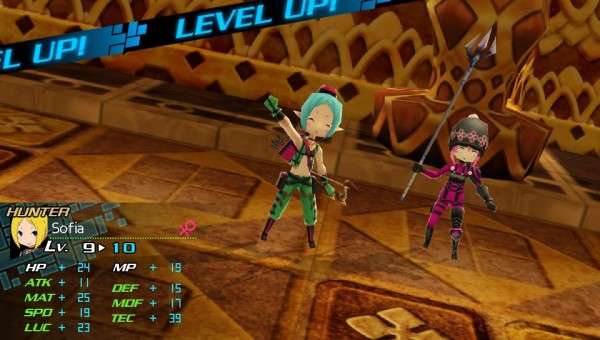
Voice acting is solid work, but some of the dialogue is stereotypical anime, which spoils some of the work done by the voice actors, but at least there is nothing here that will annoy you to the point it feels like your ear drums have set on fire. One thing I really enjoyed was the soundtrack. It’s based on poppy Japanese music that keeps you feeling upbeat and is super catchy, like any good cheesy music should be. Masato Kouda is the mind behind the songs, and has worked on other original soundtracks for titles such as Devil May Cry, Monster Hunter, El Shaddai, and Chaos Legion, so there is quality behind the work.
Conception II: Children of the Seven Stars is a silly game that shouldn’t be taken seriously. It’s got an amusing gameplay mechanic that serves as an interesting way create unique party members, plus the fast paced action and dungeon exploring has an addictive nature that makes you want to see through the game to the end. The game’s soundtrack is great and catchy that you’ll be humming the tunes, and the game’s performance on the Vita is nothing to snuff at with its silky smooth frame rate. It’s not a great RPG – it’s too easy for starters – but I feel Conception II: Children of the Seven Stars is good enough that I can recommend this B-tier social linking, dungeon crawler to the diehard JRPG fans looking for a unique twist on the genre for their Vita.
